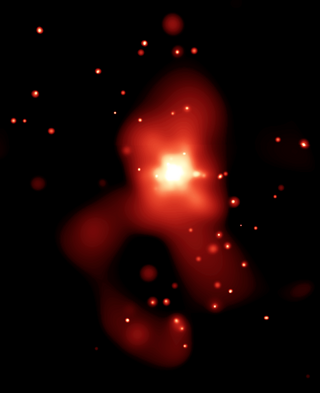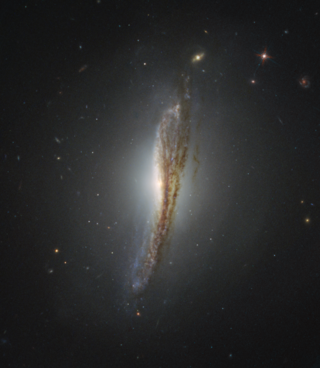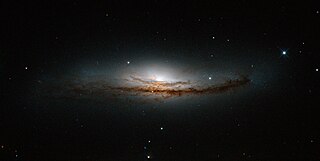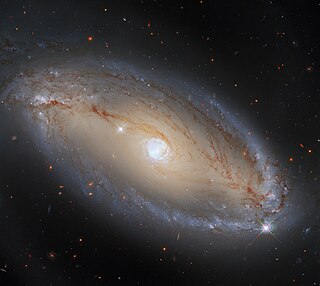Related Research Articles

A BL Lacertae object or BL Lac object is a type of active galactic nucleus (AGN) or a galaxy with such an AGN, named after its prototype, BL Lacertae. In contrast to other types of active galactic nuclei, BL Lacs are characterized by rapid and large-amplitude flux variability and significant optical polarization. Because of these properties, the prototype of the class was originally thought to be a variable star. When compared to the more luminous active nuclei (quasars) with strong emission lines, BL Lac objects have spectra dominated by a relatively featureless non-thermal emission continuum over the entire electromagnetic range. This lack of spectral lines historically hindered identification of the nature and distance of such objects.

NGC 4194, the Medusa merger, is a galaxy merger in the constellation Ursa Major about 128 million light-years (39.1 Mpc) away. It was discovered on April 2, 1791 by German-British astronomer William Herschel. Due to its disturbed appearance, it is object 160 in Halton Arp's 1966 Atlas of Peculiar Galaxies.

NGC 4261 is an elliptical galaxy located around 100 million light-years away in the constellation Virgo. It was discovered April 13, 1784, by the German-born astronomer William Herschel. The galaxy is a member of its own somewhat meager galaxy group known as the NGC 4261 group, which is part of the Virgo Cluster.
The Whole Earth Blazar Telescope (WEBT) is an international consortium of astronomers created in 1997, with the aim to study a particular category of Active Galactic Nuclei (AGN) called blazars, which are characterized by strong and fast brightness variability, on time scales down to hours or less.

NGC 708 is an elliptical galaxy located 240 million light-years away in the constellation Andromeda and was discovered by astronomer William Herschel on September 21, 1786. It is classified as a cD galaxy and is the brightest member of Abell 262. NGC 708 is a weak FR I radio galaxy and is also classified as a type 2 Seyfert galaxy.

NGC 612 is a lenticular galaxy in the constellation of Sculptor located approximately 388 million light-years from Earth. It is a type II Seyfert galaxy and thus has an active galactic nucleus. NGC 612 has been identified as an extremely rare example of a non-elliptical radio galaxy, hosting one of the nearest powerful FR-II radio sources.

1ES 1101-232 is an active galactic nucleus of a distant galaxy known as a blazar. It is also a BL Lac object.

NGC 5793 is an active spiral galaxy located approximately 150 million light years away in the constellation Libra. It is classified as a Type 2 Seyfert galaxy and was discovered by Francis Leavenworth in 1886. The galactic plane is inclined at an angle of 73°, giving it an oval, nearly edge-on appearance with the major axis aligned along a position angle of 150°.

NGC 5728 is an active barred spiral galaxy located 146 million light years away in the southern constellation of Libra. It was discovered on May 7, 1787 by William Herschel. The designation comes from the New General Catalogue of J. L. E. Dreyer, published in 1888. It has an apparent visual magnitude of 13.40 and spans an angle of 3.4 arcminutes. The galaxy shows a red shift of 0.00935 and has a heliocentric radial velocity of 2,803 km/s. It has an estimated mass of 72 billion times the mass of the Sun and stretches around 30 kpc across.
The Parkes Catalogue of Radio Sources, also known as the Parkes Southern Radio Source Catalog, consists of 8264 astronomical radio sources, mostly south of declination +27. The catalogue was mostly compiled by John Bolton and his colleagues for 20 years. Both the Molonglo 408-MHz survey and the 80-MHz Culgoora measurements of Slee et al have contributed to the usefulness of the catalogue. For now, the catalogue only contains sources originally found in the Parkes 2700-MHz survey. The catalogue contains radio sources that have a frequency range of 80 - 22,000 MHz.

NGC 3998 is a lenticular galaxy located in the constellation Ursa Major. It was discovered on April 14, 1789, by the astronomer William Herschel. At a distance of 45 million light-years, it is located relatively nearby, making it a well-studied object.

AP Librae is a BL Lacertae object located at a distance of 700 million light years in the southern constellation of Libra. In the visual band it is one of the most active blazars known. AP Lib is surrounded by an extended source with a spectrum characteristic of a red-shifted giant elliptical galaxy. The derived visual magnitude of this region is 15.0, and it follows a radially decreasing brightness that is characteristic of an elliptical. Seven fainter galaxies are visible within an angular radius of 9′, suggesting it is the brightest member of a galactic cluster.

NGC 3786 is an intermediate spiral galaxy located 107.5 million light-years away in the northern constellation of Ursa Major. It was discovered by English astronomer John Herschel on April 10, 1831. This object appears to form a close pair with its peculiar neighbor to the north, NGC 3788. They show some indications of interaction, such as minor distortion of the disk or tidal features.

NGC 5273 is a lenticular galaxy located 54 million light-years away in the northern constellation of Canes Venatici. This galaxy was discovered by William Herschel on May 1, 1785. It is positioned 1+1⁄4° to the southeast of the star 25 Canum Venaticorum.

4C +29.30 is an elliptical galaxy located in Cancer constellation. Its redshift is 0.064840 which corresponds to a light travel time of 850 million light-years from Earth. It is a wide-angled tailed radio galaxy (WAT) and a Seyfert galaxy.

PKS 1144-379 also known as PKS B1144-379, is a quasar located in the constellation of Centaurus. At the redshift of 1.048, the object is located nearly 8 billion light-years from Earth.

PKS 0805-07 also known as PMN J0808-0751 and 4FGL J0808.2-0751, is a quasar located in the constellation of Monoceros. With a redshift of 1.83, light has taken at least 10 billion light-years to reach Earth.

1ES 1741+196 is a BL Lacertae object located in the constellation of Hercules. It is located 1.2 billion light years from Earth. It was first discovered in 1996 via an Einstein Observatory X-ray satellite. Because the galaxy's synchrotron peak is found above 1 keV, it is categorized as a high-frequency peaked object.

PKS 1830-211 is a gravitationally-lensed blazar in the southern constellation of Sagittarius, one of the most powerful such objects known. It has a high redshift (z) of 2.507, an indicator of its significant distance. This flat-spectrum radio quasar (FSRQ) is one of the brightest extraterrestrial radio sources. In visible light, identification of this object is hampered by the galactic plane and an M-type star that lies near the line of sight.

PKS 0735+178 is a classical BL Lac object in the northern constellation of Gemini. This is one of the brightest objects of its type in the night sky. It has a redshift of z = 0.424, with a luminosity distance of 7,380 million light-years (2,263 Mpc). PKS 0735+178 is a nearly point-like source with an angular size of a milliarcsecond.
References
- 1 2 Charlot, P.; et al. (2020), "The third realization of the International Celestial Reference Frame by very long baseline interferometry", Astronomy and Astrophysics, 644: A159, arXiv: 2010.13625 , Bibcode:2020A&A...644A.159C, doi:10.1051/0004-6361/202038368, S2CID 225068756.
- 1 2 García-Pérez, A.; et al. (March 2024), "Powerful Radio Sources in the Southern Sky. III. First Results of the Optical Spectroscopic Campaign", The Astrophysical Journal Supplement Series, 271 (1), id. 8, Bibcode:2024ApJS..271....8G, doi: 10.3847/1538-4365/ad159e .
- ↑ Véron-Cetty, M.-P.; Véron, P. (2010), "A catalogue of quasars and active nuclei", Astronomy & Astrophysics , 518 (A10) (13th ed.): A10, Bibcode:2010A&A...518A..10V, doi: 10.1051/0004-6361/201014188 .
- ↑ "ESO 362-21". SIMBAD . Centre de données astronomiques de Strasbourg . Retrieved 2024-10-19.
- ↑ Tingay, S. J.; Edwards, P. G. (August 2002), "The Parsec-Scale Structure and Evolution of PKS 0521-365", The Astronomical Journal, 124 (2): 652–661, Bibcode:2002AJ....124..652T, doi:10.1086/341391.
- ↑ Danziger, I. J.; et al. (March 1985), "The multi-faceted active galaxy PKS 0521 - 36", The Messenger, 39: 20, Bibcode:1985Msngr..39...20D.